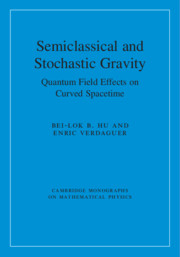Book contents
- Frontmatter
- Dedication
- Contents
- Preface
- 1 Overview: Main Themes. Key Issues. Reader’s Guide
- Part I Effective Action and Regularization, Stress Tensor and Fluctuations
- Part II Infrared Behavior, 2PI, I/N, Backreaction and Semiclassical Gravity
- Part III Stochastic Gravity
- Part IV Cosmological and Black Hole Backreaction with Fluctuations
- 12 Cosmological Backreaction with Fluctuations
- 13 Structure Formation in the Early Universe
- 14 Black Hole Backreaction and Fluctuations
- Part V Quantum Curvature Fluctuations in de Sitter Spacetime
- References
- Index
14 - Black Hole Backreaction and Fluctuations
from Part IV - Cosmological and Black Hole Backreaction with Fluctuations
Published online by Cambridge University Press: 20 January 2020
- Frontmatter
- Dedication
- Contents
- Preface
- 1 Overview: Main Themes. Key Issues. Reader’s Guide
- Part I Effective Action and Regularization, Stress Tensor and Fluctuations
- Part II Infrared Behavior, 2PI, I/N, Backreaction and Semiclassical Gravity
- Part III Stochastic Gravity
- Part IV Cosmological and Black Hole Backreaction with Fluctuations
- 12 Cosmological Backreaction with Fluctuations
- 13 Structure Formation in the Early Universe
- 14 Black Hole Backreaction and Fluctuations
- Part V Quantum Curvature Fluctuations in de Sitter Spacetime
- References
- Index
Summary
We begin with a brief description of the work on (a) the regularization of the stress-energy tensor of quantum fields in Schwarzschild spacetime in the 80s and (b) the black hole end-state and information-loss issues in the 80s, the ‘black hole complementarity principle’ of the 90s and the recent ‘firewall’ conjecture and its controversies. We then treat two classes of problems: (1) the backreaction of Hawking radiation on a black hole in the quasi-stationary regime, which occupies the longest span of a black hole’s life, and (2) the metric fluctuations of the event horizon of an evaporating black hole. In (1) the far field case can be solved analytically via the influence functional, highlighting nonlocal dissipation and colored noise; for the near horizon case we describe a strategy by Sinha et al. for treating the backreaction and fluctuations. In (2) we describe Bardeen’s model and discuss the results of Hu and Roura, who reached the same conclusion as Bekenstein, namely, that even for states regular on the horizon the accumulated fluctuations become significant by the time the black hole mass has changed substantially, well before reaching the Planckian regime. These results have direct implications for the end-state issue.
- Type
- Chapter
- Information
- Semiclassical and Stochastic GravityQuantum Field Effects on Curved Spacetime, pp. 423 - 464Publisher: Cambridge University PressPrint publication year: 2020

